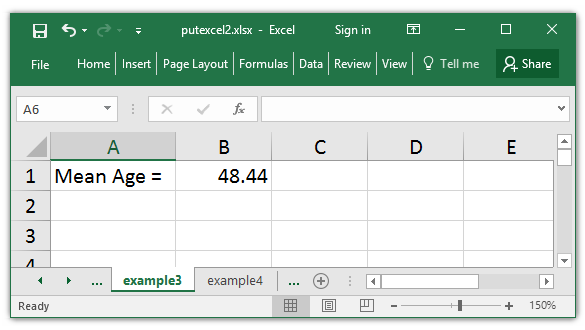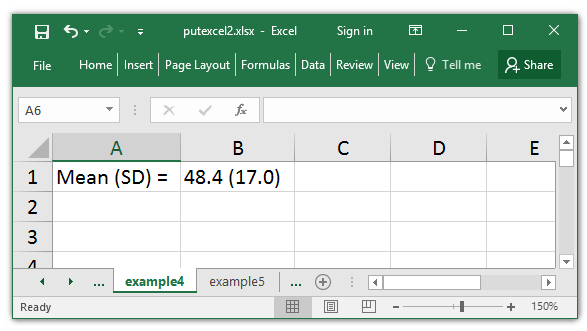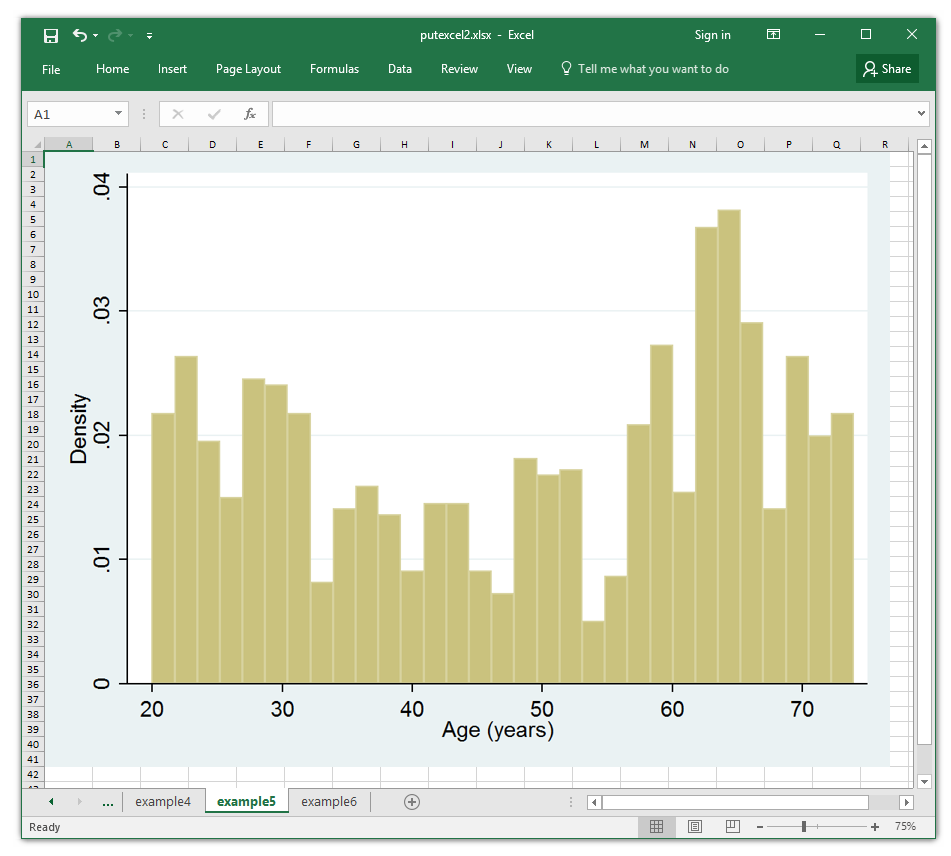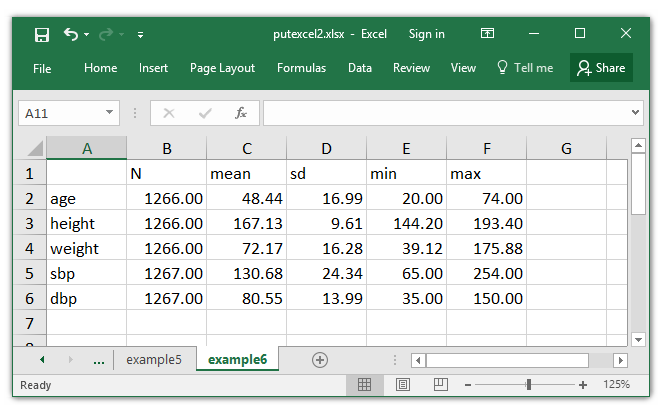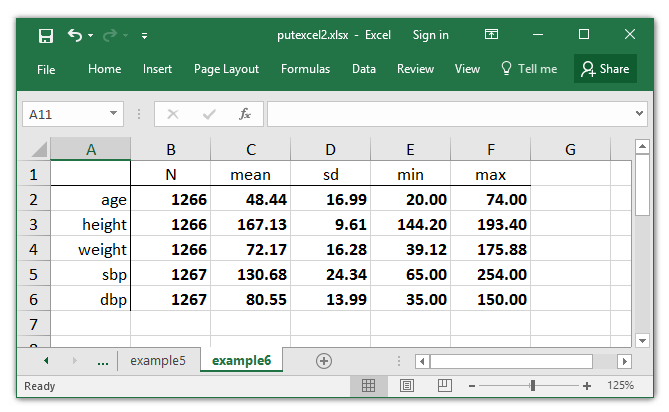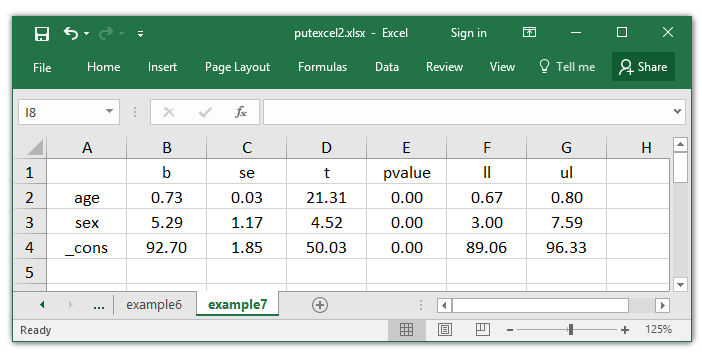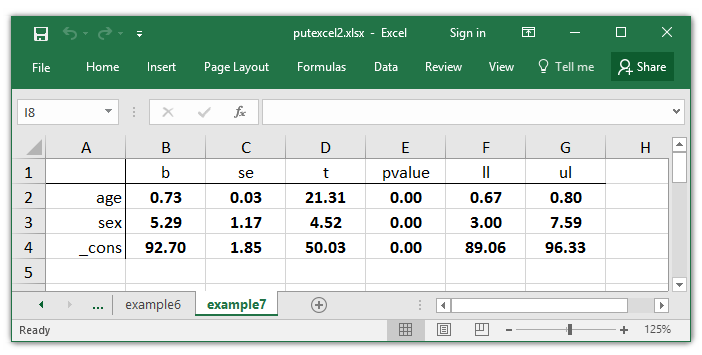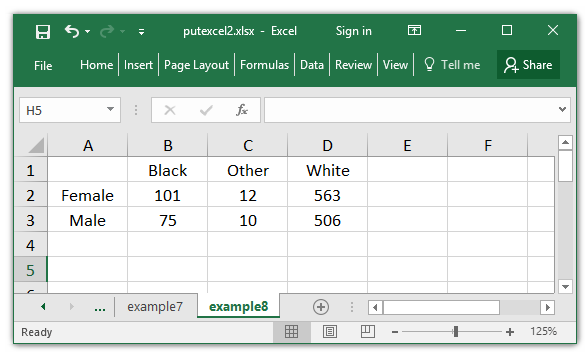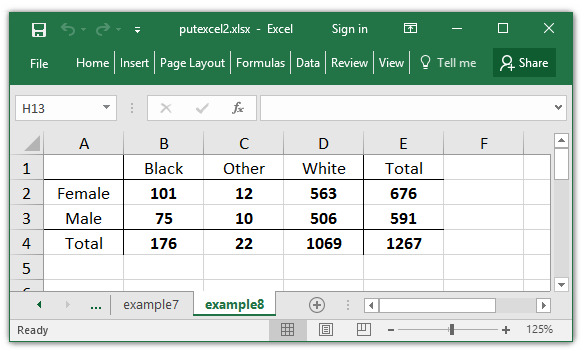Creating Excel tables with putexcel, part 2: Macro, picture, matrix, and formula expressions
In my last post, I showed how to use putexcel to write simple expressions to Microsoft Excel and format the resulting text and cells. Today, I want to show you how to write more complex expressions such as macros, graphs, and matrices. I will even show you how to write formulas to Excel to create calculated cells. These are important steps toward our goal of automating the creation of reports in Excel.
Before we begin the examples, I want to point out that I am going to create a single Excel file called putexcel2.xlsx and write each example to a separate sheet within that file. So the putexcel set commands will look like this:
putexcel set putexcel2.xlsx, sheet(example1) replace putexcel set putexcel2.xlsx, sheet(example2) modify ... putexcel set putexcel2.xlsx, sheet(example8) modify
I could create a separate Excel file for each example, but I would prefer to have a single file with multiple sheets. You may wish to use a similar approach when creating large reports.
You can download the dataset used in the examples by typing webuse nhanes2. I am using a subset of the data and have relabeled some of the variables so don’t be concerned if your numbers don’t match mine exactly.
Example 1: Writing returned results to Excel
Many Stata commands return scalars, macros, and matrices. We can write each of these to an Excel table using putexcel. For example, I might wish to write the mean of age to Excel. I can type return list after summarize age to see a list of returned results. The mean is stored in the scalar r(mean).
. summarize age
Variable | Obs Mean Std. Dev. Min Max
-------------+---------------------------------------------------------
age | 1,266 48.44076 16.98858 20 74
. return list
scalars:
r(N) = 1266
r(sum_w) = 1266
r(mean) = 48.44075829383886
r(Var) = 288.6119026656426
r(sd) = 16.98858153777539
r(min) = 20
r(max) = 74
r(sum) = 61326
I begin by setting the destination to the sheet “example1” in the file putexcel2.xlxs. I can then write the expression “Mean Age = ” to cell A1 and the expression `r(mean)’ to cell B1. Note that r(mean) is enclosed in single quotes. This tells Stata that I want to write the value of r(mean) to cell B2.
. putexcel set putexcel2.xlsx, sheet(example1) replace Note: file will be replaced when the first putexcel command is issued . putexcel A1 = "Mean Age = " file putexcel2.xlsx saved . putexcel B1 = `r(mean)' file putexcel2.xlsx saved
I can open the resulting Excel file and see that the mean was successfully written to cell B2.
Example 2: Formatting numbers with Excel formats
I can specify the display format of a number using Excel formats in the nformat() option. For example, I could display the mean with three decimal places using the option nformat(“#.###”).
. putexcel set putexcel2.xlsx, sheet(example2) modify
. putexcel A1 = "Mean Age = "
file putexcel2.xlsx saved
. putexcel B1 = `r(mean)', nformat("#.###")
file putexcel2.xlsx saved
You can view a complete description of Excel’s formatting options in the Options section of [P] putexcel advanced.
Example 3: Formatting numbers with Stata formats
Stata includes many shortcut format codes that can be used with nformat(). For example, I could display the mean with two decimal places using the option number_d2.
. putexcel set putexcel2.xlsx, sheet(example3) modify . putexcel A1 = "Mean Age = " file putexcel2.xlsx saved . putexcel B1 = `r(mean)', nformat(number_d2) file putexcel2.xlsx saved
You can view a complete list of codes for numeric formats in the Appendix of [P] putexcel.
Example 4: Formatting numbers with the string() function
I could also report the mean and standard deviation in a single cell. This can be accomplished in two steps. First, I store r(mean) and r(sd) to the local macros meanage and sdage, respectively. The string() function allows me to specify one decimal place. Second, I create a local macro named meansd that combines meanage and sdage into a single expression. Note that I must use double quotes in the command putexcel B1 = “`meansd'” because meansd is a string.
. // put the mean of age in a cell using the string() function . putexcel set putexcel2.xlsx, sheet(example4) modify . putexcel A1 = "Mean (SD) = " file putexcel2.xlsx saved . local meanage = string(`r(mean)',"%9.1f") . local sdage = string(`r(sd)',"%9.1f") . local meansd = "`meanage' (`sdage')" . putexcel B1 = "`meansd'" file putexcel2.xlsx saved
Example 5: Adding a graph to an Excel file
I might wish to include a histogram of age in my Excel file. First, I create the histogram and use graph export to save the graph to a .png file.
. histogram age (bin=31, start=20, width=1.7419355)
. graph export age.png, replace (file age.png written in PNG format)
Then, I can put the graph in the spreadsheet using the expression picture(age.png)
. putexcel set putexcel2.xlsx, sheet(example5) modify . putexcel A1 = picture(age.png) file putexcel2.xlsx saved
Example 6: Writing a matrix to Excel
Some Stata commands return matrices. For example, I can use tabstat to calculate descriptive statistics for a list of variables. The save option tells tabstat to save the results to a matrix.
. tabstat age height weight sbp dbp, stat(n mean sd min max) save
stats | age height weight sbp dbp
---------+--------------------------------------------------
N | 1266 1266 1266 1267 1267
mean | 48.44076 167.1308 72.17252 130.6843 80.54854
sd | 16.98858 9.61487 16.28185 24.34302 13.99187
min | 20 144.199 39.12 65 35
max | 74 193.398 175.88 254 150
------------------------------------------------------------
When I type return list, I see that tabstat returned the matrix r(StatTotal).
. return list
matrices:
r(StatTotal) : 5 x 5
. matlist r(StatTotal)
| age height weight sbp dbp
-------------+-------------------------------------------------------
N | 1266 1266 1266 1267 1267
mean | 48.44076 167.1308 72.17252 130.6843 80.54854
sd | 16.98858 9.61487 16.28185 24.34302 13.99187
min | 20 144.199 39.12 65 35
max | 74 193.398 175.88 254 150
I would prefer to create an Excel table that looks like the output from summarize with variables in rows and statistics in columns. So I create a matrix called results, which is equal to the transpose of r(StatTotal).
. matrix results = r(StatTotal)'
. matlist results
| N mean sd min max
-------------+-------------------------------------------------------
age | 1266 48.44076 16.98858 20 74
height | 1266 167.1308 9.61487 144.199 193.398
weight | 1266 72.17252 16.28185 39.12 175.88
sbp | 1267 130.6843 24.34302 65 254
dbp | 1267 80.54854 13.99187 35 150
Then, I write the matrix results to Excel using the expression matrix(results). I could use the expression matrix(r(StatTotal)’) rather than creating a new matrix, but I wanted to show you the transposed matrix before writing it to Excel. The upper-left corner of the matrix will be placed in cell A1 of the Excel table. The names option tells putexcel to write the row and column names to Excel along with the matrix. The nformat(number_d2) option tells putexcel to display the matrix with two decimal places.
. putexcel set putexcel2.xlsx, sheet(example6) modify . putexcel A1 = matrix(results), names nformat(number_d2) file putexcel2.xlsx saved
Next, I would like to format the Excel table to make it look more like a table of results rather than a matrix. I can change the format of a cell without writing anything to the cell. I can even format a range of cells using the syntax ul:br, where ul is the upper-left corner of the cell range and br is the bottom-right cell.
The sample sizes for each variable displayed in cells B2:B6 do not need two decimal places. I can display cells B2:B6 with no decimals using the nformat(number) option. The option overwritefmt tells putexcel to overwrite the existing cell format.
. putexcel B2:B6, nformat(number) overwritefmt file putexcel2.xlsx saved
Next, I format the cells A1:A6. The right option aligns the text to the right side of the cells, and the border(right) option adds a border to the right side of the cells.
. putexcel A1:A6, right border(right) overwritefmt file putexcel2.xlsx saved
I format cells A1:F1 similarly. The hcenter option centers the labels horizontally, and the border(bottom) option adds a border to the bottom of cells A1:F1.
. putexcel A1:F1, hcenter bold border(bottom) overwritefmt file putexcel2.xlsx saved
Finally, I display the numbers in cells B2:F1 using a bold font to make the table look similar to the output of summarize.
. putexcel B2:F6, bold file putexcel2.xlsx saved
The formatted Excel table looks like this:
Example 7: Writing regression coefficients to Excel
Most Stata regression commands return the table of coefficients in a matrix named r(table). For example, I could fit the following linear regression model with regress.
. regress sbp age sex
Source | SS df MS Number of obs = 1,266
-------------+---------------------------------- F(2, 1263) = 236.23
Model | 204030.521 2 102015.261 Prob > F = 0.0000
Residual | 545432.459 1,263 431.854678 R-squared = 0.2722
-------------+---------------------------------- Adj R-squared = 0.2711
Total | 749462.98 1,265 592.460854 Root MSE = 20.781
------------------------------------------------------------------------------
sbp | Coef. Std. Err. t P>|t| [95% Conf. Interval]
-------------+----------------------------------------------------------------
age | .7328247 .0343946 21.31 0.000 .6653479 .8003014
sex | 5.292591 1.170872 4.52 0.000 2.995522 7.58966
_cons | 92.6976 1.852992 50.03 0.000 89.06232 96.33289
------------------------------------------------------------------------------
and type matlist r(table) to see the coefficient matrix.
. matlist r(table)
| age sex _cons
-------------+---------------------------------
b | .7328247 5.292591 92.6976
se | .0343946 1.170872 1.852992
t | 21.30641 4.520211 50.02589
pvalue | 2.65e-86 6.76e-06 6.9e-302
ll | .6653479 2.995522 89.06232
ul | .8003014 7.58966 96.33289
df | 1263 1263 1263
crit | 1.961844 1.961844 1.961844
eform | 0 0 0
r(table) contains the rows df, crit, and eform, which are not displayed in the regression output. I would like to reproduce the table of coefficients in my Excel table, so I store r(table) to the matrix results, extract the first six rows of results, and then transpose results.
. matrix results = r(table)
. matrix results = results[1..6,1...]'
. matlist results
| b se t pvalue ll ul
-------------+------------------------------------------------------------------
age | .7328247 .0343946 21.30641 2.65e-86 .6653479 .8003014
sex | 5.292591 1.170872 4.520211 6.76e-06 2.995522 7.58966
_cons | 92.6976 1.852992 50.02589 6.9e-302 89.06232 96.33289
Now, I can write results to my Excel file.
. putexcel set putexcel2.xlsx, sheet(example8) modify . putexcel A1 = matrix(results), names nformat(number_d2) hcenter file putexcel2.xlsx saved
A few adjustments to the font and cell formats make my matrix look more like a table of coefficients.
. putexcel B2:G4, bold overwritefmt file putexcel2.xlsx saved . putexcel A1:A4, right border(right) overwritefmt file putexcel2.xlsx saved . putexcel A1:G1, hcenter border(bottom) overwritefmt file putexcel2.xlsx saved
Example 8: Writing cross-tabulations to Excel
We can also write the results from tabulate to Excel using matrices. The matcell() option stores the cell counts from tabulate in a matrix. For example, I can store the results of the tabulate command below in the matrix cellcounts.
. tabulate sex race, matcell(cellcounts)
| Race
Sex | Black Other White | Total
-----------+---------------------------------+----------
Female | 101 12 563 | 676
Male | 75 10 506 | 591
-----------+---------------------------------+----------
Total | 176 22 1,069 | 1,267
. matlist cellcounts
| c1 c2 c3
-------------+---------------------------------
r1 | 101 12 563
r2 | 75 10 506
I can rename the rows of cellcounts with the value labels from sex using the following steps. First, sex is stored as a numeric variable, so I can use decode to create a string variable called sex_s. I could omit this step if sex was stored as a string variable. Next, I use levelsof to store the levels of sex_s to the local macro sexlabels. Then, I use matrix rownames to label the rows of cellcounts with the labels stored sexlabels.
. decode sex, generate(sex_s)
. levelsof sex_s, local(sexlabels)
`"Female"' `"Male"'
. matrix rownames cellcounts = `sexlabels'
. matlist cellcounts
| c1 c2 c3
-------------+---------------------------------
Female | 101 12 563
Male | 75 10 506
I can use the same steps to rename the columns of cellcounts with the value labels of race.
. decode race, generate(race_s)
. levelsof race_s, local(racelabels)
`"Black"' `"Other"' `"White"'
. matrix colnames cellcounts = `racelabels'
. matlist cellcounts
| Black Other White
-------------+---------------------------------
Female | 101 12 563
Male | 75 10 506
I can then write cellcounts to Excel just like I did in the last two examples.
. putexcel set putexcel2.xlsx, sheet(example9) modify . putexcel A1 = matrix(cellcounts), names hcenter file putexcel2.xlsx saved
This approach worked, but there are no row and column totals in my Excel table. One way to add them is to put calculated cells in the table using formula() expressions. For example, the first line of putexcel below puts the Excel function SUM(B2:D2) in cell E2. This calculates the total for the first row of the table. The putexcel command below puts formulas in the table to calculate the row, column, and overall totals.
. putexcel E2 = formula(=SUM(B2:D2)) /// > E3 = formula(=SUM(B3:D3)) /// > B4 = formula(=SUM(B2:B3)) /// > C4 = formula(=SUM(C2:C3)) /// > D4 = formula(=SUM(D2:D3)) /// > E4 = formula(=SUM(B2:D3)), hcenter file putexcel2.xlsx saved
I can visually differentiate the row and column totals from the cells by adding labels and borders. I can also display the numbers with a bold font.
. putexcel A4 = "Total" E1 = "Total", hcenter file putexcel2.xlsx saved . putexcel A1:A4 D1:D4, border(right) overwritefmt file putexcel2.xlsx saved . putexcel A1:E1 A3:E3, border(bottom) overwritefmt file putexcel2.xlsx saved . putexcel B2:E4, bold file putexcel2.xlsx saved
The Excel table looks similar to the output from tabulate.
Re-creating Stata output in Excel tables is easy with putexcel using returned scalars, macros, and matrices. Examples 1-7 generalize well for arbitrary variables, but I hardcoded the row and column totals for the variables sex and race in example 8.
Next time, I will show you how to generalize these examples for arbitrary variables and put more eleborate expressions in the table cells.


